Angela Ackerman's Blog: Writers Helping Writers, page 36
May 16, 2023
Character Voice Versus Author Voice

We���ve all heard about the importance of finding your voice as a writer. Maybe you���ve had a critique from an editor who felt the narrative voice wasn���t sharp enough. Or maybe a critique mentioned the author���s voice creeping into the narrative and you found yourself thinking, huh? Isn���t that the voice I worked so hard to develop in the first place?
Well, yes. And no.
We each have a voice that we write in, and it���s as individual as a fingerprint. A novel by Margaret Atwood will sound different than one by Stephen King, and while this might be related to both genre and characters, there���s an ineffable quality to each author���s voice that seeps into their work regardless of how hard they might try to keep it out.
The trick is not to let that voice break the fictional dream you���ve created in your work.
This can happen in several ways: when the author has an agenda they���re trying to slip into the story; when they inadvertently break the POV by stepping in to comment on something; and when they succumb to the temptation to use what Elmore Leonard calls hooptedoodle.
Having an AgendaWhen we write a novel, we often (hopefully) have something to say. Let���s call it a theme, the answer to the dreaded so what? question. The line between theme and message, however, is a thin one, and if you���re not subtle enough about your intentions, your reader will sense you���re trying to teach them something and will back away.
Having something to say should not be the same as telling readers what to think. It���s always better to give readers questions to ponder rather than answers to swallow. So, if you have an agenda, shelve it. Give us something to think about. But don���t tell us we have to think like you.
As Ursula le Guin so elegantly puts it, a story���s job is to achieve meaning; it���s a door that opens onto a new world. Messages are for sermons. If all you see in The Hobbit is a message about greed, you���ve missed the magic.
Let the Narrator Narrate
When the author���s voice creeps into a defined POV, you pull your reader out of the fictional dream. It���s jarring. In fact, this gets to the heart of POV, where consistent character voice is crucial to reader immersion.
In any deep POV you choose, you���ll be seeing the world through someone else���s eyes. That means everything���from what they notice to the analogies they draw���must be filtered through a lens that is not your own. Douglas Glover calls this language overlay, and it���s one of the most useful POV pointers I���ve ever come across. A sailor will not think the same way as a baker, and this difference can run deep. As an example, the sailor might always have one eye on the weather; a baker might be perpetually attuned to smells. Your teen narrator who suddenly knows the Latin names of plants will pull readers out of the story scratching their heads and wondering how this narrator has such easy access to this specialized information. Not to say it can���t work. If the narrator���s mother is a botanist and has been teaching him the Latin names of plants from the time he was a toddler, it will add another layer to his character. But that has to be established in the story.
An objective POV is all about what can be seen on the surface, so the author���s voice definitely shouldn���t be part of that. And in omniscience, there is still a narrator���but unless it���s you, the reader shouldn���t hear your voice.
Avoid HooptedoodleOur name might be on the cover of the book we���ve written, but we should never take center stage in our novel unless we���re doing something funky with metafiction. One of the ways we sneak ourselves into our work is with fancy writing that calls attention to itself for no other reason than to wave a flag and say look what I can do.
I���m a huge fan of poetic writing, but I���m also a firm believer in the importance of double duty. Every element in a novel should do more than one thing. A pretty description of the weather should also be a reflection of mood or an ironic foreshadowing or whatever else you have up your sleeve. If you���ve written a whole paragraph about the dark billowing sky, let it also reflect a building dread in the narrator or allow it to serve as a reminder that the body he dropped into the lake might not have been weighted down with enough rocks.
But if that billowing sky is only there for the reader to admire, then it sounds like writing. And as Elmore Leonard also said: ���If it sounds like writing, I rewrite it.���
Do your readers a favor: either take it out or give it a second job.
Finding Your Voice
The notion of finding your voice has never made sense to me. Your voice is who you are. No matter whose shoes you���re wearing in a particular novel, your voice will come through. If you don���t believe that, try reading one author���s entire body of work. You���ll meet a room full of characters who might all sound different, but there will also be something humming beneath them that they share: the person who created them.
You don���t have to find your voice. You are your voice.
What you have to do is write. A lot. Learn how to handle POV so that you, the author, remain the silent partner in this weird agreement you make with your readers when you bring a world to life. Don���t remind the reader that they���re reading a story. Allow them to believe in the dream.
As for crafting a character���s voice, well��� that���s a topic that deserves its own post. Which it will have next time you see me here.The post Character Voice Versus Author Voice appeared first on WRITERS HELPING WRITERS��.
May 12, 2023
Character Type and Trope Thesaurus: Explorer
In 1959, Carl Jung first popularized the idea of archetypes���”universal images that have existed since the remotest times.” He posited that every person is a blend of these 12 basic personalities. Ever since then, authors have been applying this idea to fictional characters, combining the different archetypes to come up with interesting new versions. The result is a sizable pool of character tropes that we see from one story to another.
Archetypes and tropes are popular storytelling elements because of their familiarity. Upon seeing them, readers know immediately who they’re dealing with and what role the nerd, dark lord, femme fatale, or monster hunter will play. As authors, we need to recognize the commonalities for each trope so we can write them in a recognizable way and create a rudimentary sketch for any character we want to create.
But when it comes to characters, no one wants just a sketch; we want a vibrant and striking cast full of color, depth, and contrast. Diving deeper into character creation is especially important when starting with tropes because the blessing of their familiarity is also a curse; without differentiation, the characters begin to look the same from story to story.
But no more. The Character Type and Trope Thesaurus allows you to outline the foundational elements of each trope while also exploring how to individualize them. In this way, you’ll be able to use historically tried-and-true character types to create a cast for your story that is anything but traditional.
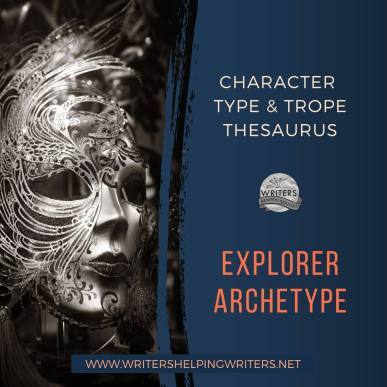 Explorer Archetype
Explorer ArchetypeDESCRIPTION
Explorers thrive on adventure and discovery. These trailblazers are unafraid of new experiences or challenges, and boldly moving into the unknown is a part of their identity.
FICTIONAL EXAMPLES: Indiana Jones (Indiana Jones Series), Captain Picard (Star Trek), Lara Croft (Tomb Raider), Evelyn O’Connell (The Mummy Franchise)
COMMON STRENGTHS
Adaptable, Adventurous, Ambitious, Appreciative, Bold, Confident, Curious, Decisive, Focused, Idealistic, Independent, Observant, Passionate, Persistent, Resourceful, Spontaneous, Wise
COMMON WEAKNESSES
Abrasive, Cocky, Impatient, Impulsive, Macho, Manipulative, Obsessive, Possessive, Rebellious, Reckless, Selfish, Stubborn, Temperamental, Withdrawn, Workaholic
ASSOCIATED ACTIONS, BEHAVIORS, AND TENDENCIES
Nomadic tendencies (being on the move, never staying too long in one place)
Not needing much in the way of creature comforts
Having fewer attachments (to things, people, places)
Having a broad understanding of people, cultures, and customs
Knowing more than one language
Being highly spontaneous
Being a ‘figure it out as I go’ sort of person
Having a strong sense of purpose and a clear goal at all times
Able to think on their feet and adapt to changing circumstances
Being able to learn the rules of a new environment quickly
Excellent survival and navigation skills
Recovering from disappointments quickly and moving on
Being drawn in by stories
Being curious about people, places, and experiences
A desire to see and experience things first hand
Always being up for a trip, outing, or adventure
Being unafraid of new circumstances or challenges
Being a thrill-seeker
Not being turned off by danger or risk
More likely to act on instinct rather than through a deep analysis
The ability to size people up quickly
Needing to be talked out of things, rather than talked into them
Preferring their own company to the company of others
A tendency to believe the ends justify the means (when they believe in the cause)
Being a lifelong learner
Focusing on the journey, not the goal
A tendency to push to find their own limits (and then push to challenge them further)
Fearing a boring life more than anything else
SITUATIONS THAT WILL CHALLENGE THEM
Having no choice but to wait because another is in control of when things happen
Having to adhere to a routine
Being unable to travel (due to illness, legal restrictions, an injury, family responsibilities, etc.)
Being anchored by duty (becoming a caregiver to an elderly parent, having to run a family business, raising a child, etc.)
Being bound by rules and limitations
Having to give up personal freedom to serve the greater good
Being stuck in a single place for too long
Finding time for healthy, two-way relationships
Finding someone to talk through their feelings or struggles because while they may know a lot of people, few are close enough for those type of conversations
Being around people who are closed-minded and see the world in absolutes
INNER STRUGGLES TO GIVE THEM DEPTH
Feeling selfish for wanting to be out discovering new things when it means others must stay behind and pick up the slack
Wanting to have relationships but knowing the other party will only end up feeling neglected
Feeling guilt for abandoning people when the next adventure calls
Guilt over risk-taking that impacts others negatively
Regret over what they chose to give up (possibly a place to call home, close family bonds, a life partner, etc.)
Knowing the personal growth they seek may come at the price of a lonely life
TWIST THIS TROPE WITH A CHARACTER WHO���
Finds ways to be dependable while making room for adventure
Gives back as a teacher or leader who encourages others to embrace open-mindedness
Becomes a role model to someone who is dependent or insecure, showing them how to become more independent
Is an explorer who is unselfish, putting the needs of others first
CLICH��S TO BE AWARE OF
The ���lone wolf��� adventurerThe explorer who inspires deep loyalty despite never being around to nurture relationshipsThe adventurer who only travels to far off, obscure placesBeing a collector of antiquities and objects when the lifestyle doesn���t support materialismOther Type and Trope Thesaurus entries can be found here.
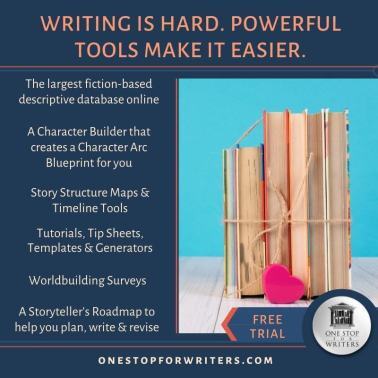 Need More Descriptive Help?
Need More Descriptive Help?While this thesaurus is still being developed, the rest of our descriptive collection (16 unique thesauri and growing) is accessible through the One Stop for Writers THESAURUS database.
If you like, swing by and check out the video walkthrough for this site, and then give our Free Trial a spin.
The post Character Type and Trope Thesaurus: Explorer appeared first on WRITERS HELPING WRITERS��.
May 11, 2023
Creating a Publication Timeline for Your Next Release
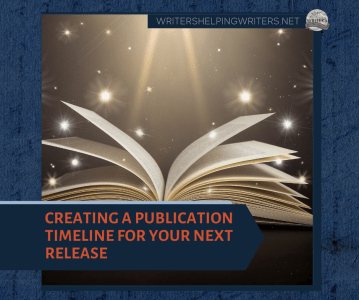
Publishing your own book is a lot like juggling���and not those harmless little balls, either. Try a couple of balls, a chainsaw, a set of Ginsu knives, and a litter of kittens. There are so many things to remember, and they���re all vital to getting your book into readers��� hands in a reasonable timeframe. Drop any of those balls and you end up with a messy or unfinished product that doesn���t reflect the time and energy you���ve put into it.
One thing Angela and I started doing early in our career was creating a publication timeline for each book. This allowed us to track the things that had to get done, plan how long each step would take, and determine a reasonable launch deadline.
These timelines have been crucial to us being able to release our books in a timely fashion without forgetting anything important. And eight books later, we���re still using the same template. Today I���d like to share my process with you so you can do the same.
1. Make a List of Tasks Needed to Publish Your BookWhat jobs will need to be done for your book to be published? Some of these are universal���writing the book, revising it, designing a cover, etc. But others will be specific to you and the kind of book you���ve written. To get you started, here���s our list of Must-Dos, which can be tweaked to fit your process.
Drafting: Each nonfiction book that Angela and I write consists of two portions: instructive front matter and thesaurus entries. We tackle each section separately, so they���re listed as such on our spreadsheet.
Revision: The length for this part of the process will vary between authors and from project to project.
Professional Editing: We���ve come a long way from the self-publishing stigma that was so pervasive when we published our first book in 2012. A lot of that is due to authors recognizing the need to create a polished product. When you���ve done as much with your manuscript as you can, hire a professional to take it to the next level. Because of the unusual format of our nonfiction books, Angela and I hire an editor to tidy up the narrative front matter and a proofreader to fine-tooth-comb the entry section, but that won���t be necessary for everyone.
Drawer Time: After so much time focusing on a book, we start to lose perspective; we���re so close to it that we can no longer see the issues. To gain a little distance, stick it in the ���drawer��� for a while. Work on something else. Then, when you come back to it, you can give it a final read-through with fresh eyes to catch anything you may have missed.
Cover Design: Whether you do it yourself or hire someone, you���ll need to create a cover for your book.
Formatting: This is the final step in the process of creating the actual book. Again, you can do this job yourself or hire it out.
Marketing for Your Launch: What���s your marketing plan? How will you get the word out about your book? Make note on your timeline of the different strategies you���ll employ, such as crafting a launch-related newsletter, soliciting testimonials, hiring a street team, or sending out requests to write guest posts for influential blogs around the time of your release.
Publishing: Decide where you���re going to sell your books (Amazon, Apple, on your website, etc.). Familiarize yourself with their timelines so you���ll know how long it takes for an uploaded file to be available for purchase. This will ensure that your books can be bought at the various distributors by your launch date.
Miscellaneous Pre-Launch Stuff: There are lots of nitpicky tasks that need to be done before your book goes live: creating blurbs, updating your bio, adding the book to your website bookstore, obtaining an ISBN���all the little things that don���t fit into bigger categories. Dropping them into a Miscellaneous section on your timeline is a good way to remember them so they don���t creep up on you.
Other Considerations: Our spreadsheet isn���t comprehensive; it excludes a lot of common tasks such as obtaining feedback from beta readers and setting up preorders. And that���s fine. Everyone���s process is different. As you set up your own timeline, you can include anything we���ve omitted and remove the tasks that aren���t necessary.
Once you���ve created your list of tasks, put them into a spreadsheet, as follows. Then you���re ready for the next step.
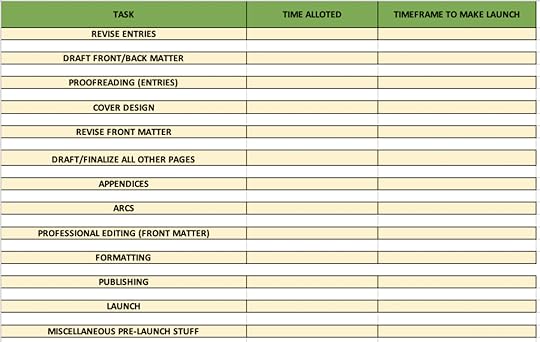 2. Split Tasks into Subtasks
2. Split Tasks into SubtasksSome jobs will require multiple steps. You want to note these under each task so you don���t forget them.
3. Assign Time Estimates for Each Task and Subtask.If you���ve written books before, you���ll know how long it will take to draft, revise, and the like. If this will be your first time, make your best guess; you can always adjust, as long as you���ve added enough buffer into your overall timeline (more on that later). For tasks that will be handled by others, decide early on who you���ll be working with. Ask them in advance how long they���ll need to complete your cover design or format a project like yours. Add time estimates for each task and subtask to your spreadsheet. Here���s how our timeline started for The Occupation Thesaurus:
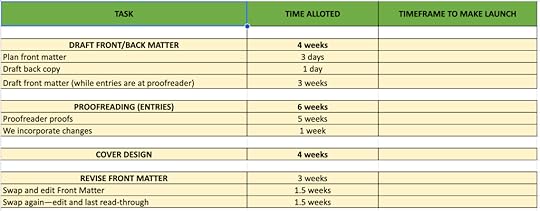 4. Order Your Tasks.
4. Order Your Tasks. Most of the steps to publication go in a logical sequence: drafting, then revising, then formal editing, etc. But some jobs can overlap. For instance, you may decide to do your cover design or beta reading during that important drawer time. You might be able to start some marketing incentives while the book is still being formatted. Arrange your tasks so you can see the order in which they need to be accomplished.
5. Decide on a Launch DateNow that you know the tasks you���ll be handling and how much time is needed for each, you can decide on a release date. Add up the time allotted for all the tasks to see how much will be needed overall. Then get out the calendar and choose a launch date that will give you enough time to do everything on your list. Be sure to plan around family vacations, holidays, big work projects, and any other events that would make it difficult for you to focus on your launch.
One other thing you���ll want to factor into your timeline is what I like to call Buffer. No matter how carefully you plan, things go wrong. Your cover designer goes out of business and you have to find a new one, beta feedback requires you to make major changes, a family situation crops up that steals your writing time ��� Trust me, you will need more time than you think you do, so add some buffer into your timeline. You won���t see it on our sheet because I don���t physically add a line item for buffer; I just add an extra 3-4 weeks to the overall timeframe and choose a launch date with that in mind. This may sound like overkill, but Angela and I have needed at least some of that buffer for every release. And if you end up finishing ahead of schedule, great. You���ve got some time to breathe before jumping into your marketing campaign.��
6. Work Backwards to Assign Timeframes to Each TaskOnce you���ve got a launch date in mind, work backwards from that date to fill in the timeframes for each task so you���ll know when each one needs to be done. For The Occupation Thesaurus, we needed about 4 1/2 months, including buffer, so we decided to shoot for a release date of 7/20. The item on my spreadsheet that���s just prior to launch is Publishing. Seeing that I have to upload and publish my digital files at various distributors five days before launch, I plan to do that on 7/15. Next, I���ve got a note that my Amazon files should be published a week before the release date, so I���ll do those on 7/13. Print files have to be uploaded even earlier, because I have to order a proof and make sure the paper copy looks good. I allot three weeks for that (in case anything goes wrong and I have to make changes and order a second proof), so I plan to upload the print file three weeks before launch, on 6/23.
That takes care of all the publishing tasks. So I move up to formatting. My formatter needs about three weeks, so I plan to get her the material on 5/25 in hopes that I���ll have the finished files by 6/19. Then I move on to the task that comes before formatting���
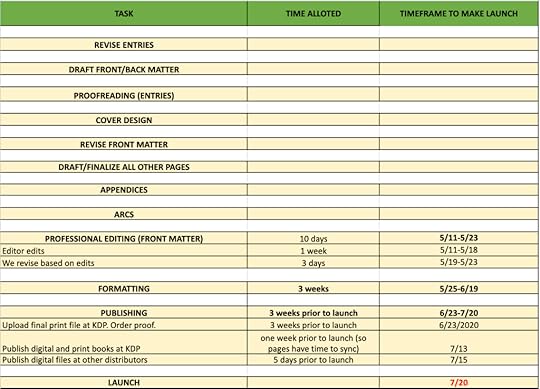
In this way, work your way backward until you���ve assigned dates for all the tasks. This process will tell you when, at the latest, you should start working through your list so you���ll be done in time for your launch. And it acts as a schedule to keep you on track as you go. Here���s what ours looked like for this particular publication:
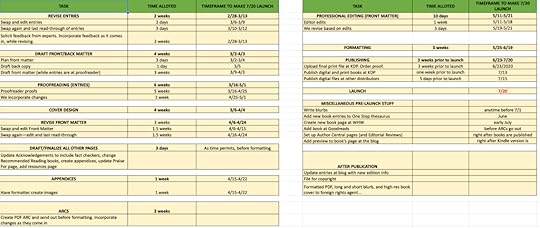
This may seem like a lot of work, but it���s worth it because you only have to do it once. Then, when it���s time to publish your next book, the spreadsheet is there, with the necessary tasks and timeframes laid out. All you have to do is adjust the dates so they fit your new launch date. It makes things SO much easier.
This sheet is also handy because it allows you to note what doesn���t work so you can make changes for the next publication. For instance, prior to this publication, we���d always sent out ARCs as PDFs after the book was formatted (so readers had the cleanest version to read). But we learned that if readers find typos and other errors, it was too late for us to go back and remove them because the files had already been formatted. We made a note for future publications to create a quick PDF from the manuscript and send those out as ARCs before we got to the formatting stage so we could incorporate any changes before the files were finalized.
This timeline has been an absolute lifesaver for us and has made the jump to self-publishing much more manageable. And it can do the same for you. We���d love for you to use our spreadsheet as a template and individualize it to fit your next project. And if you have questions about the process, I���m here to answer them.
The post Creating a Publication Timeline for Your Next Release appeared first on WRITERS HELPING WRITERS��.
May 9, 2023
How Beta Readers Might Save Your Book from Disaster

When I wrote book 2 in my The Fountain Series, The West Woods, I posted on social media to get Beta Readers, and had 61 people offer. *Facepalm*. I didn���t want to sift through 61 opinions on my book, but I did need a gut check from fans of the series.
Would they like it as much as Book 1?Would they accept that Book 2 is a prequel?Would they forgive my main character, Courtney, for the things she did in Book 1?These were the worries I had. So, from the 61, I invited a dozen, including teens and adults who read Young Adult. (Fun fact if you write for Young Adults ��� Adults are the ones who buy the books, and also the ones who review them, because kids don���t have Amazon accounts, so you need to make sure your book satisfies them too!)

Now, if you are lucky enough to find Beta Readers, treat them like gold. They are not your proofreaders. They are not editors. And unless they are also writers, they may not have the skills to suggest how you can improve your book. The skill you need from them is being readers, and letting them react to the story you���ve written.
Many of my Beta Readers have never given a writer feedback before, so I make it as clear as possible what I need them to do. That way, they don���t have to stress that they���re ���not doing it right���, or that they���ll somehow let me down if they don���t love everything about the book. Bring on the feedback, because once it���s out in the world, you can���t take it back.
Writers often ask me when to involve Beta Readers. I like to get this feedback before I send it to my editor, so that I���ve got a good idea of how others will receive it. If I���m on a short timeline, I also sometimes send it to my editor and Beta Readers at the same time and then incorporate all the changes that come out of their reviews in the same revision pass.
The first thing I do is give my Beta Readers a clear timeline. I like to ask them to read my book in 2 weeks. Here���s a quick tip: If you send your book to Beta Readers, and they don���t finish it? That might be feedback in itself. I hope that once readers start it, they rip through it cover to cover, just to find out what happens.
And to let them enjoy it and not stress, I make it clear that I don���t expect them to edit along the way. Instead, I give them a list of questions to answer when they���re done reading, including what characters they liked the most, and who they liked the least, which scene was their favorite, which was their least favorite, etc. Want the exact questions I asked Beta Readers for The West Woods? You can grab them here, I���m happy to share.
I sent PDF copies of the book to the adult readers, and I printed, bound, and mailed out hard copies of the manuscript for the teen readers (I���ve found they���re more likely to be able to read it on the go, or evenings if they don���t have to use a device). And 2 weeks later, the feedback rolled in.
I sat down to go through the feedback and look for trends, taking a deep breath. After the third set of answers, I started to relax. The book was in good shape. I wouldn���t have to gut it. A few minor tweaks and it would be off to the publisher.
I went through the adult feedback first. They enjoyed the book. They connected with the main character and her story. And every one of them said that the climax scene ��� involving a dramatic break up ��� was their favorite. No surprise there, it had everything. I���d spent a long time perfecting that moment. Readers said it was heart wrenching and raw. Exactly what I was going for.

Next, I moved on to the teens��� feedback. I read the first set of answers, and then the second��� and my shoulders crept up around my neck. The teens said the break up was their least favorite scene.
���It made me so sad I had to put the book down for a few days������I cried for her, and it just wasn���t as uplifting as Book 1���I stared at their answers, stunned. I���d been so focused on ripping my readers��� hearts out, I hadn���t stopped to consider what readers loved about Book 1. Why teens were reading the series in the first place.
After a few days mulling over how to completely rework the climax of the book, I highlighted the 5 chapters that needed to change, and hit delete. (Okay, okay, of course, I didn���t really hit delete, but I moved them into another document and never looked at them again). Spoiler alert: There is no longer a break up scene in that book, and it went on to be shortlisted as a finalist for the Aurora Awards for Best Young Adult Fiction in Canada.
I am so grateful for the teens who were brave enough to tell me what the least favorite part of their book was. And I���m grateful I asked.
Are you looking for Beta Readers for your book? Check out this terrific article.Have more questions on how to use Beta Readers effectively? Drop a comment below!The post How Beta Readers Might Save Your Book from Disaster appeared first on WRITERS HELPING WRITERS��.
May 6, 2023
Character Type and Trope Thesaurus Entry: Creator
In 1959, Carl Jung first popularized the idea of archetypes���”universal images that have existed since the remotest times.” He posited that every person is a blend of these 12 basic personalities. Ever since then, authors have been applying this idea to fictional characters, combining the different archetypes to come up with interesting new versions. The result is a sizable pool of character tropes that we see from one story to another.
Archetypes and tropes are popular storytelling elements because of their familiarity. Upon seeing them, readers know immediately who they’re dealing with and what role the nerd, dark lord, femme fatale, or monster hunter will play. As authors, we need to recognize the commonalities for each trope so we can write them in a recognizable way and create a rudimentary sketch for any character we want to create.
But when it comes to characters, no one wants just a sketch; we want a vibrant and striking cast full of color, depth, and contrast. Diving deeper into character creation is especially important when starting with tropes because the blessing of their familiarity is also a curse; without differentiation, the characters begin to look the same from story to story.
But no more. The Character Type and Trope Thesaurus allows you to outline the foundational elements of each trope while also exploring how to individualize them. In this way, you’ll be able to use historically tried-and-true character types to create a cast for your story that is anything but traditional.
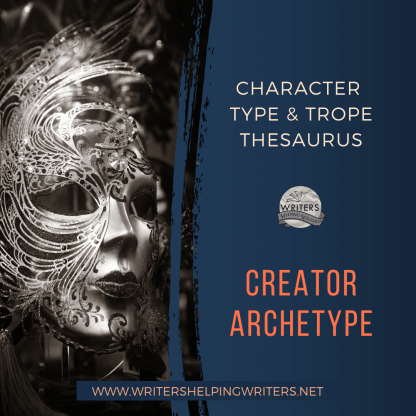 Creator (Archetype)
Creator (Archetype)DESCRIPTION: Imaginative and highly driven, these characters are the artists, inventors, and scientists who feel compelled to create something totally new and innovative. Their motivation may come from a desire to write a wrong, solve a problem, meet a need, fill a personal void, or simply provide fulfillment for themselves.
FICTIONAL EXAMPLES: Victor Frankenstein (Frankenstein), Willy Wonka (Charlie and the Chocolate Factory), Jo March (Little Women), Mozart (Amadeus), Zeus (Greek mythology)
COMMON STRENGTHS: Adventurous, Ambitious, Bold, Creative, Curious, Disciplined, Focused, Idealistic, Imaginative, Independent, Industrious, Inspirational, Intelligent, Meticulous, Passionate, Persistent, Quirky, Resourceful, Talented, Uninhibited
COMMON WEAKNESSES: Compulsive, Disorganized, Irresponsible, Manipulative, Oversensitive, Perfectionist, Possessive, Self-Indulgent, Stubborn, Uncooperative, Volatile, Workaholic
ASSOCIATED ACTIONS, BEHAVIORS, AND TENDENCIES
Being a visionary; imagining things that don’t yet exist
Thinking outside the box
Asking lots of questions
Being gifted in a given area (science, music, art, coding, etc.)
Using unconventional methods
Being highly disciplined where work is concerned
Embracing risk
Making personal sacrifices to bring their vision to fruition
Recognizing failure as a necessary part of the process
Having a long-haul perspective; understanding that creation is a process that takes timePreferring to work alone
Being hyper-focused on their work, to the exclusion of everything else
Difficulty managing their time
Struggling with deadlines
Being impatient with details and minutia
Being quirky or odd
Living on the fringes of acceptable or “proper” society
Exhibiting obsessive behaviors
Prioritizing their creative efforts over everything and everyone else
Neglecting self-care (forgetting to eat, not showering, etc.) when a project is underway
Using drugs, caffeine, or other stimulants to stay awake
Perfectionism
Seeing the flaws in even an extraordinary creation
Being hard on themselves
Foregoing marriage and children so they can be fully devoted to their art
Moodiness
Feeling misunderstood
Difficulty taking criticism from others
Sacrificing ethics and morality on the altar of creation
Struggling with personal relationships because people will always come second to the muse
SITUATIONS THAT WILL CHALLENGE THEM
Encountering a creative block
Being unable to create (due to time constraints, social pressures, lack of resources, etc.)
A physical or mental challenge requiring medication that saps their creativity
Having to take a job that provides financial stability but means less time for creative efforts
Having a clear vision but being unable to develop it with current technology
Being actively discouraged from pursuing a dream
Being distracted (by a new love interest, current events, other creative ideas, etc.)
INNER STRUGGLES TO GIVE THEM DEPTH
Doubting their abilities
Wanting to grow but being resistant to constructive criticism
Struggling to innovate while others in their field are having great success
Perfectionism keeping the character from enjoying small successes
Struggling with ethical and moral questions surrounding their work
Using creation to fill an internal void, but it doesn’t bring satisfaction or fulfillment
Wrestling with addiction
Refusing to acknowledge a mental health condition because the treatment would impact the character’s creative abilities
TWIST THIS TROPE WITH A CHARACTER WHO���
Works well with others and values collaboration
Is incredibly talented but keeps their creations hidden from others
Is inspired by the act of creation itself and is unconcerned with the quality of their work
Embraces any physical or mental conditions and incorporates them into their process
Is an extrovert who loves being with people
Works with an off-putting medium or creates things that are disturbing
Has an atypical trait: analytical, cautious, organized, fussy, lazy, traditional, etc.
CLICH��S TO AVOID
The tortured artist, plagued by their own demons
The creator who uses drugs to enhance their abilities
The mad scientist whose obsession has driven them insane
Megalomaniac creators with a god complex
Other Type and Trope Thesaurus entries can be found here.
 Need More Descriptive Help?
Need More Descriptive Help?While this thesaurus is still being developed, the rest of our descriptive collection (16 unique thesauri and growing) is accessible through the One Stop for Writers THESAURUS database.
If you like, swing by and check out the video walkthrough for this site, and then give our Free Trial a spin.
The post Character Type and Trope Thesaurus Entry: Creator appeared first on WRITERS HELPING WRITERS��.
May 4, 2023
Adversarial Conflict: Who Is Making Trouble In Your Story?
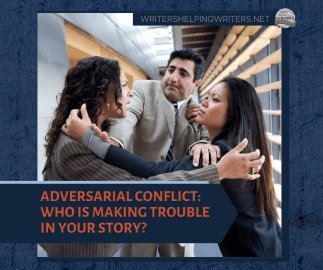
Is there anything better than well-written conflict? The vengeful enemy, sharks circling a sinking boat, a carefully guarded secret getting out in the open.
Readers, fearful for the characters they love, grip the book tighter when conflict is close.
What will happen? Will everything be okay?
The more dire the threat, the more uncertain they feel.
Conflict holds power in storytelling because it touches everything: pacing, plot, stakes, characterization, character arc, emotion, you name it. Internal or external, subtle or obvious, readers invested in the book will find themselves in a near-constant state of tension as they worry about the character���s ability to dodge story knives.
One of the biggest sources of conflict comes in the form of an adversary���someone (or something) that has goals, needs, desire, or a purpose that clashes with the protagonist���s own. Once their paths cross, BOOM. Friction, tension, conflict! A battle of wills, might, and minds ensues until one is victorious.
Adversaries generate a lot of conflict, meaning it���s important to know their motivations and intentions. If they have a big role, we should brainstorm them just as we would the protagonist (here���s a tool to help with that) to understand what���s driving them. But are all adversaries the same? Not at all. Depending on what you need, you have a variety of adversarial players to choose from. Here are some considerations for each.
CompetitorThis foe is someone who has the same goal as the protagonist and will compete for it. Whether your character is up against a peer for a scholarship, a job, an award, or something else, make sure their competitor has abilities, skills, resources, or other assets that will make the outcome uncertain.
RivalLike a competitor, this opponent wants the same thing as your protagonist. What���s different though is that the rival is also invested in defeating the protagonist. The victory is personal because there���s some sort of history between the two.
Consider the ongoing friction between Johnny Lawrence and Daniel LaRusso (and, later, their competing dojos) in the TV series, Cobra Kai. Johnny and Daniel took very different paths since their initial battle in The Karate Kid. Daniel became a wealthy and successful businessman while Johnny worked handyman jobs and flirted with alcoholism as an escape from his personal failings, losses, and abuse trauma. Old wounds are reopened when Johnny reopens Cobra Kai to empower youths, and Johnny���s son trains with Daniel to get back at his dad. Further complications abound as their teenage kids start dating and Johnny fights to become someone better while Daniel holds firm to old biases. The result of all this friction? A boatload of rivalry-fueled conflict.
AntagonistThis is often a catchall term for the main adversary. If the antagonist is a person, they will have a mission or agenda that counters the protagonist���s and most likely are prominent enough to have a character arc of their own.
Antagonist ForceThe foe standing between your character and their goal doesn���t need to be a person. Depending on the story, the antagonistic force could be an element of nature (the brutal polar vortex in The Day after Tomorrow), an animal (the wolf pack hunting plane crash survivors in The Grey), or even a type of technology (The Terminator).
Villain
A villain is different than an antagonist in the sense that there is an element of evil or a specific intent to hurt others. Something has skewed their worldview and made them into who they are���a person whose moral code runs on a completely different track. Villains have no qualms about mowing down anyone who gets in the way of their goal.
EnemyThis type of foe is a threat to your protagonist and those they���re aligned with. An enemy can be a person, collective, family, or even a concept that threatens to do great damage. If the enemy is someone your character once had an amicable relationship with, the moment the two choose opposition, previous attachments are cast aside.
InvaderSome people are all about disrupting the status quo; they want what others have���be it land, power, resources, or lives���and are there to take it. Invaders are the aliens in Independence Day, the death-eaters laying siege to Hogwarts, and the highwaymen from Alas, Babylon.
Frenemy
This adversary is someone your character may align with at times, but a competition exists that requires an emotional shield to always be in place. Frenemy relationships are often between peers (co-workers, members of the same social clique, etc.), and peace is kept if conditions remain stable. As soon as one character���s position is elevated (they���re given more attention, an advantage, offered an opportunity, etc.), the competition is on. Frenemy relationships are prone to jealousy and so can devolve quickly.
HaterThis character is someone who sees your protagonist as being undeserving of the good that comes to them. In general, haters struggle with the success of others, possibly due to envy, jealousy, and feelings of personal inadequacy. Haters are disruptors and saboteurs who look for opportunities to cause problems and ���take someone down a peg.���
BullyThis opponent gains power by controlling others. Bullies can exist in any environment, from the mean-spirited boss who enjoys pushing your character around, to the adult sibling that never lost his adrenaline rush at sliding the brotherly (or sisterly) knife in. The closer a bully is to your character, the more they can exploit their weaknesses.
AggressorSome who struggle to manage their feelings have a go-to response to discomfort or fear: aggression. When a threat is perceived, the aggressor responds impulsively, using intimidation, verbal and emotional abuse, or violence to neutralize the threat. Aggressors are volatile and dangerous because once triggered, they don���t back down.
MeddlerChances are, some people around your character have strong opinions and aren���t afraid to share them. But if they consistently try to insert themselves or interfere, they become meddlers. This type is somewhat passive-aggressive, offering unsolicited feedback and intrusive advice���or, worse, actively interfere to achieve a specific end. Meddlers are those the character has an emotional attachment to, so rather than directly calling them out, your character may put up with it until they eventually explode.
NemesisOnce in a great while an adversary comes along who is powerful, relentless, and enduring. This is a foe that, to date, has not been bested and so their very presence is a thorn your protagonist obsesses over but can���t remove. Superman has Lex Luther, Harry Potter has Voldemort. Both parties long for the destruction or removal of the other but have been unable to bring that about.
ChallengerSometimes your character is at the top of the food chain���happy, secure, and in control. They might be the director of an important area of the government, have the most prosperous grocery store in town, or they���re dating the prom queen. In other words, life is good. Enter the challenger���someone in a position to take what your character has.
Supernatural ForceInhuman adversaries present a specific challenge because they usually have powers and abilities your protagonist does not. This makes the matchup uneven and will require your character to rethink what they know and believe to find a way to overcome this threat.
Adversarial conflict can be direct or indirect, but always requires a reason for existing.Choosing an antagonist just because your character ���needs someone to beat��� will lead to hollow conflict, so develop each character to unearth their why instead. Who has something to prove and why? Is this about payback or something else? Is a belief or identity on the line? Adversary or protagonist, when readers can clearly line up the character���s motivation to their goals and needs, it gives credibility to their actions, choices, and behavior.
 Need more ideas?
Need more ideas? You���ll find problems, obstacles, ticking clocks, temptations, moral dilemmas and more in The Conflict Thesaurus: A Writer���s Guide to Obstacles, Adversaries, and Inner Struggles Volume 1 and Volume 2.
Let the conflict brainstorming begin!
The post Adversarial Conflict: Who Is Making Trouble In Your Story? appeared first on WRITERS HELPING WRITERS��.
May 2, 2023
Using Wound Categories & Pointed Questions to Identify a Character���s Past Trauma
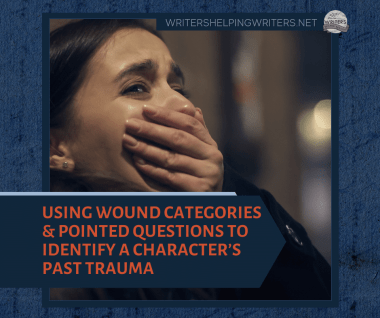
The wound is a fascinating and vital piece of your character���s past that has lasting, formative effects on who they���ll be at the start of your story. As such, it���s super important to figure out which wound is crippling your character so you���ll know how to write them realistically and consistently. Whether you���re building characters from the ground up or they come to you fully formed and you just have to figure out their backstory, it���s imperative to identify this important event.
What Is an Emotional Wound?Simply put, a wound is a negative past experience or series of experiences that causes extensive emotional pain. It could be a devastating moment (a life-threatening accident), repeated traumatic episodes (living with an abusive caregiver), or an ongoing damaging situation (growing up in poverty).
However it manifests, this excruciating event births powerful fears that begin to drive the character���s behavior and choices. New personality traits develop as a way of protecting the character from re-experiencing that trauma or the emotions associated with it.
How Do You Discover Your Character���s Wound?There are a number of ways to ferret out this information, but today I���d like to share a simple brainstorming method involving the different kinds of wounds. It can be difficult to examine these events closely, but knowing the categories and asking some pointed questions about your character can help you figure out which kinds of trauma are a distinct possibility. The list of potential wounds becomes much more manageable.
1. Traumatic EventsThese are the ones that most easily come to mind because of their dramatic nature.

A school shooting, a diagnosis of terminal illness, a fatal car crash���these are singular moments of devastation that easily stand out as changing the course of a character���s life. Because of this, these wounds are often the easiest to identify.
Questions to Ask: Is there a specific traumatic moment from the past that haunts your character?
2. Misplaced Trust and BetrayalsBeing betrayed by a sibling, getting dumped, suffering childhood abuse by a trusted adult���wounds like these are often the hardest to overcome because they���re inflicted by the people who should love and protect us. It���s those closest to us who can do the greatest harm, so wounds like these are sadly common.
Questions to Ask: Which people from your character���s past did he trust and look up to the most? How might any of them have betrayed him?
3. Childhood WoundsI joke a lot about how my parenting mistakes will provide good therapy fodder for my kids. I hope that doesn���t happen, but it���s true that some of the most lasting wounds occur in childhood. Children are more vulnerable than adults, and they���re less capable of coping positively when something horrible happens. As a result, these traumas can be more difficult to overcome.
Questions to Ask: Which memories from your character���s childhood does she shy away from? Who were the trusted and most-loved people in her life, and how might they have mistreated her? Which of her caregiver���s techniques, beliefs, or philosophies does she adamantly reject and will never use with her own children?
4. Injustice and HardshipVery often, our difficult circumstances come about due to an inequity (real or perceived) that someone exploits, such as when a character is bullied, experiences discrimination, or is wrongfully imprisoned. Moments like these often result in disillusionment with the people, groups, or establishment that failed the character, making it easy to unearth the wounding event: just follow that trail of breadcrumbs back to the originating event.
Questions to Ask: Does your character harbor resentment or anger toward a person, people group, or organization? On the flip side, does he feel apathy toward anyone, believing the person is too powerful or established to be confronted? What happened that caused these feelings?
5. Crime and VictimizationWounds in this category come about when the character is targeted and victimized, making them fairly straightforward and easy to identify. Examples include having your identity stolen, being stalked, and having one���s home being broken into.
Questions to Ask: At what point was my character the victim of a crime?
6. Disabilities and Disfigurements
These kinds of wounds can be both physically and emotionally crippling because they set the character apart from others. Her difference (whether physical, mental, or emotional) is often perceived to be a weakness or limitation by the character herself or by the people around her. It makes her ���less than,��� setting real or imagined limitations on what she can do and achieve.
Questions to Ask: How did the physical disfigurement or disability occur? Is my character haunted by that event or by something that resulted afterward, such as being bullied about her disability or failing in some way because of it?
7. Failures and MistakesMistakes are a normal, everyday part of life that don���t usually result in lasting harm. But some are more devastating, such as when the fallout is great, the event negatively affects other people, or it impacts the character���s sense of self-worth and esteem. Wounds like these might include making a very public mistake or accidentally killing someone.
Questions to Ask: Which negative experience from the past is my character in some way legitimately responsible for? Is there an event that dredges up feelings of extreme guilt, making him wish he could go back and undo it?
Once you���ve decided which kind of wound makes sense for your character, it becomes easier to zero in on the exact trauma that has befallen him. To this end, we���ve put together an extensive (though far from comprehensive)��list of possible wounding events��broken down by category. Then it becomes a simple matter of examining a short list of possibilities to determine which one is haunting your character, impacting him even into the current story.
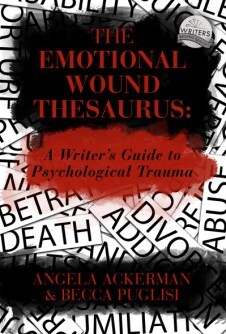 For more information, you might want to check out��The Emotional Wound Thesaurus.��You can also add it to your��Goodreads��shelf or view a sample entry:��Accidentally Killing Someone.
For more information, you might want to check out��The Emotional Wound Thesaurus.��You can also add it to your��Goodreads��shelf or view a sample entry:��Accidentally Killing Someone.Finally, if you want to use an��expanded version of the Emotional Wound Thesaurus, hop on over to��One Stop for Writers, where you���ll find it in the largest fiction-focused description database online.
Why not give the��free trial��a spin?
The post Using Wound Categories & Pointed Questions to Identify a Character���s Past Trauma appeared first on WRITERS HELPING WRITERS��.
April 29, 2023
The Ruler Archetype
In 1959, Carl Jung first popularized the idea of archetypes���”universal images that have existed since the remotest times.” He posited that every person is a blend of these 12 basic personalities. Ever since then, authors have been applying this idea to fictional characters, combining the different archetypes to come up with interesting new versions. The result is a sizable pool of character tropes that we see from one story to another.
Archetypes and tropes are popular storytelling elements because of their familiarity. Upon seeing them, readers know immediately who they’re dealing with and what role the nerd, dark lord, femme fatale, or monster hunter will play. As authors, we need to recognize the commonalities for each trope so we can write them in a recognizable way and create a rudimentary sketch for any character we want to create.
But when it comes to characters, no one wants just a sketch; we want a vibrant and striking cast full of color, depth, and contrast. Diving deeper into character creation is especially important when starting with tropes because the blessing of their familiarity is also a curse; without differentiation, the characters begin to look the same from story to story.
But no more. The Character Type and Trope Thesaurus allows you to outline the foundational elements of each trope while also exploring how to individualize them. In this way, you’ll be able to use historically tried-and-true character types to create a cast for your story that is anything but traditional.
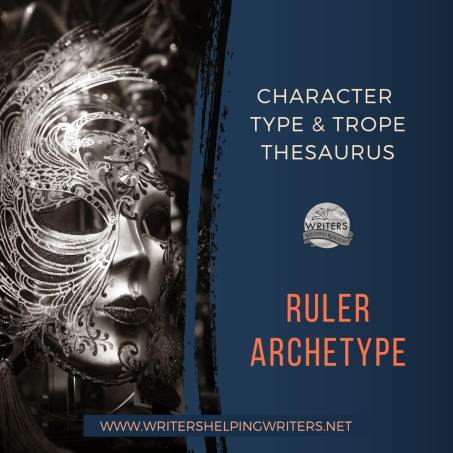 Ruler (Archetype)
Ruler (Archetype)DESCRIPTION: Rulers are those who preside over others, keeping order, protecting, and taking responsibility for the welfare of their people and lands. Rulers have vast power, which can be used to do good, or evil, and their position hinges on their ability to maintain power and control, whether achieved by good works and earning the love and respect of others, or through threat, manipulation, and fear.
FICTIONAL EXAMPLES: Aragorn (Lord of the Rings); President Snow (The Hunger Games Trilogy), Mufasa (The Lion King), Vito Corleone (The Godfather)
COMMON STRENGTHS
Ambitious, Analytical, Bold, Confident, Courageous, Decisive, Disciplined, Intelligent, Just, Loyal, Objective, Patient, Patriotic, Perceptive, Persistent, Persuasive, Protective, Responsible, Socially Aware, Tolerant, Traditional, Wise, Witty
COMMON WEAKNESSES
Cocky, Confrontational, Controlling, Evasive, Haughty, Hypocritical, Impatient, Inflexible, Judgmental, Manipulative, Materialistic, Perfectionist, Possessive, Pretentious, Violent, Volatile
ASSOCIATED ACTIONS, BEHAVIORS, AND TENDENCIES
Displaying authority and leadership
A powerful sense of duty
A strategic mindset that never turns off
Being somewhat risk-adverse and acting with caution
Always thinking about the big picture
Putting the good of the many first
Respecting traditions and customs, understanding their importance
Viewing every interaction as a way to reinforce alliances, secure needs, and further goals
Being in control of their environment (what happens and when)
Being direct when communicating (and expecting orders to be followed without question)
A defined set of morals (and high standards to go with them)
Taking ownership of failures and missteps and rarely making the same mistake twice
Being very good at masking emotion
Displaying wealth and other symbols of status and prestige
Perfectionist tendencies and having high expectations of others
Maintaining appearances even in times of stress to never appear weak or not in control
Becoming upset when things do not go as planned
Having a defined set of rules and following them (and expecting others to also)
Relying on trusted agents who have proven themselves loyal over family or class
Living in a way that maintains their reputation (be that a fair ruler, an unforgiving one, etc.)
Following through on promises, threats, and consequences
Forgetting people are people, not chess pieces for furthering goals
Having few close relationships
Rarely (or never) letting down their guard to reveal insecurities or worries
Finding it difficult to ask for help
Being mindful of their reputation and appearance
Being able to make the hard decisions when necessary
Adopting a ���the ends justify the means��� mindset at times
SITUATIONS THAT WILL CHALLENGE THEM
Having to let go of control or transfer power to another
Having to rely on someone or something that is unproven
A chaotic environment when structure and order is disrupted
Hard choices that go against their morals or ethics
Having a personal vulnerability become known
Discovering disloyalty among their inner circle
Being challenged by a competitor
Moments that require patience
Having to make concessions or compromise
Needing information to make decisions that impact others and not having it
A cognitive challenge that impairs memory or the ability to make clear decisions
Having no choice but to act in a way that will make someone an enemy
Being asked to put personal welfare first (work-life balance, tending to personal relationships, etc.)
When someone knows their secrets or has a form of leverage
INNER STRUGGLES TO GIVE THEM DEPTH
Feeling anxiety and doubt and being unable to show it or confide in anyone
Yearning for the burden of duty to be lifted, and feeling guilt for this desire
Feeling the more they embody a role, the more they lose their sense of self
Wanting to pursue something but knowing they cannot because of their duty, a custom, expectations, etc. (like choose whom to marry, be friends with, or where to live)
Struggling with burnout and having little to no opportunities for self-care
Being terrified of failing or making a mistake but having to mask it
Wanting to confess to something (a mistake, a betrayal) but knowing they cannot
TWIST THIS TROPE WITH A CHARACTER WHO���
Enjoys leading, and is good at it
Faces temptations and struggles just as anyone else would
Is not afraid to share power, and co-leads because two is stronger than one
Is a respected ruler despite not fitting the tall, strong, handsome type
Is an effective and respected leader who just happens to also have a condition, physical challenge, or other atypical factor
CLICH��S TO AVOID
Ruling with the ���iron fist��� and yet never being challenged by those unhappy with status quo
Being an inept leader and yet somehow staying in power
Treating soldiers, supporters, and staff poorly, yet somehow they all remain loyal
Being in charge due to a family legacy when others in the story make better leaders
Other Type and Trope Thesaurus entries can be found here.
 Need More Descriptive Help?
Need More Descriptive Help?While this thesaurus is still being developed, the rest of our descriptive collection (16 unique thesauri and growing) is accessible through the One Stop for Writers THESAURUS database.
If you like, swing by and check out the video walkthrough for this site, and then give our Free Trial a spin.
The post The Ruler Archetype appeared first on WRITERS HELPING WRITERS��.
April 26, 2023
Selling a Million Books: What Worked for Us (and Can Work for You, Too)
As you may know, Angela and I have recently reached the unbelievable milestone of having sold a million books.
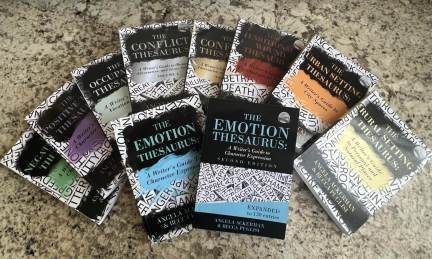 Meet the kids
Meet the kidsI say ���unbelievable��� because this was never in our sights. We started out as two writers with no formal education in the field. We had no publishing experience. What did a couple of stay-at-home moms really know about succeeding as authors?
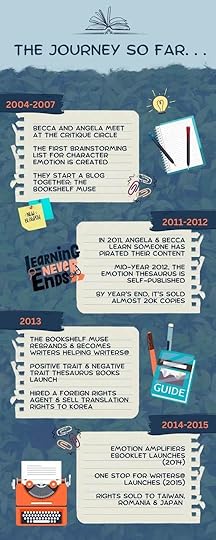
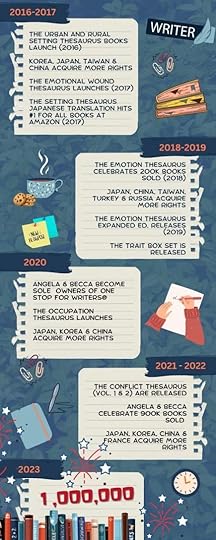
Needless to say, when we sold our thousandth book in 2012, we were over-the-moon excited. And then we hit the 10,000 mark. Then 100k��� With every milestone, people asked us how we had done it���because I think a lot of writers can relate to our feelings of uncertainty, of having a goal but not knowing how to get there, and not wanting to dream too big.
But here���s the truth: if we can succeed, you can succeed. Full stop.
Granted, it would have been easier with a little more information when we started. So we���d like to share some of the things that have worked for us, because we believe they can work for you���no matter what you���re writing or what goals you���ve set for yourself.
Give the Readers What They WantSome of you may not know that the very first thing we blogged about in 2007 was The Emotion Thesaurus. As critique partners, we had both struggled with how to show emotions in new and realistic ways, and we knew it was also a problem for the other members of our group. So we thought: maybe this is something other writers need help with, too.
That suspicion was confirmed almost immediately. We started putting up a new emotion post each Saturday, and our readership just blew up. Before long, people were asking for the content in book form. And that���s when we knew we had something people wanted to read.
Takeaway: Whether you���re writing nonfiction, cozy mysteries, thrillers, steamy romances, or a memoir, you have stories that people want to read. Write what excites you. Hone your craft so you can write those stories well. And start building connections with the people who want to read what you���re writing.
Take RisksAngela and I had always dreamed of being traditionally published, so when it came time to turn The Emotion Thesaurus into a book, we assumed we���d go that route. Then we started seeing our thesaurus content popping up on other people���s sites, and being distributed as a PDF. Suddenly, we couldn���t afford to wait two years or more for our book to be available; we had to get it out quickly before someone else did, and that meant publishing it ourselves.
But this was 2011. Self-publishing was openly poo-poohed in the industry, with many people bemoaning the substandard quality of self-pubbed books (and some asserting that authors only went this route if they couldn���t get a traditional contract). Oh, and we had zero idea how to publish a book. Going down this path was a huge risk for us, but Ange and I knew we needed to do it, so we got to work figuring out file formats, and distributors, and cover designers, and the logistics of co-authoring a book. And we made it work, and in 2012, we launched The Emotion Thesaurus.
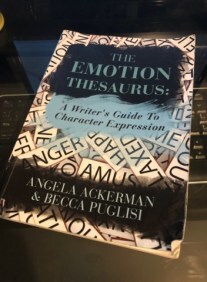 Original proof, pre-logo
Original proof, pre-logoTakeaway: Don���t be afraid to take risks with your writing. Try new things. Dive into uncharted waters and educate yourself. Sometimes, the scariest opportunities have the biggest payoffs, but you won���t reap the rewards if you don���t try.
Put Your Own Spin on Your WorkAnother thing that made us nervous was the unconventional format of our books. Instead of the typical narrative structure, our thesauruses consisted mostly of two-page entries full of lists and phrases. It was a risk to deviate from the norm, but we went for it because our blog readers liked it.
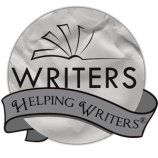
Not only did readers love the ���user-friendly��� structure, other writing books with lists soon began popping up all over Amazon.
Unfortunately, it’s also led to copycat covers and many books that have similar titles to those in our series. We feel bad every time someone tells us they bought a book they thought was one of ours only to discover it wasn’t. So if you are trying to find our thesaurus guides, just look for the Writers Helping Writers�� logo.
Takeaway: Always put your own spin on your writing. Infuse it with your unique voice. Explore the themes that interest you and the subject you���re passionate about. Write as your authentic, one-of-a-kind self and you���ll end up creating books that will stand apart from the others in your genre.
Make Your Books Available to as Many Readers as Possible
Because readers have their own preferred storefronts and formats, we wanted to reach as many of them as possible by going wide and making our books available in lots of places. We also offered PDF versions, since people like having their book files open on their computer while working. We even created a Character Traits Boxed Set to sell directly from our website.
The bulk of our sales do come from Amazon, but by distributing through many digital storefronts and independent bookstores, and making our books available in PDF, we ensured that readers could get our books where they liked to show and in the format that worked best for them.
Takeaway: Make it easy for people to buy your books. Sell through multiple distributors, in different formats. Listen to what your followers are saying about how they like to read and make those options available to them.
Explore Every OpportunityAs you grow, opportunities are going to come along that you never considered. Ange and I had published three books and were working on the fourth when we got an email from a publisher asking if the Korean rights to The Emotion Thesaurus were available. Foreign translations weren���t on our radar at all. We didn���t have an agent, couldn���t negotiate an international contract ourselves, and couldn���t market a book overseas if we wanted to. So it would���ve been easy for us to dismiss the request as being too far outside our wheelhouse and something we just didn���t have time for.
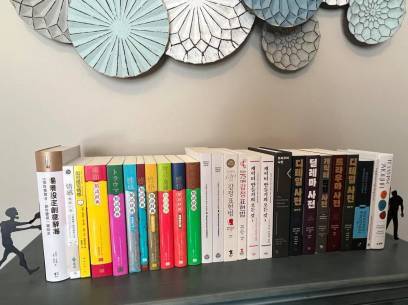 Foreign editions (and Angela’s zombie bookends)
Foreign editions (and Angela’s zombie bookends)Instead, we looked into it. We found an agent who specialized in negotiating rights deals with foreign publishers. We talked to her about the email we���d received, and we realized this was a gift that had fallen into our laps. So we sold those rights. And, boy, was that the right decision. We now have books in 9 languages that have sold almost 400,000 copies to date in markets we never would have reached on our own.
Takeaway: No matter how busy you are, explore every opportunity that comes your way. You don���t have to invest a ton of time. Just do some basic research, keep an open mind, and see if it���s something you should pursue. When in doubt, see Point #2.
Run ExperimentsIt can be hard to know if an opportunity is a good one or not. In those cases, it doesn���t hurt to experiment.
In 2018, KDP started contacting us with requests to highlight our Kindle books in their daily and monthly deals. We were skeptical about how this would affect our sales. Sure, more people might buy our Kindle book if it was priced at $1.99. But wouldn���t we end up making less money that way? Would those discounted sales cannibalize our paperback sales?
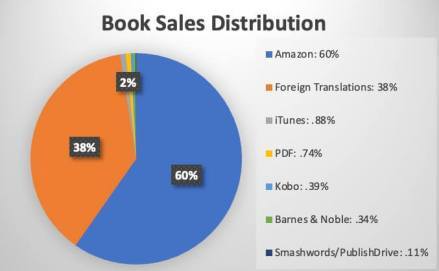 Writers Helping Writers series breakdown 2023
Writers Helping Writers series breakdown 2023So we ran an experiment and started participating in those deals. It became clear that while we made less per book, our revenue still increased. Why? Because it lowered the barrier to test out one of our thesauruses, and if the person found it helpful, they often would go on to pick up more volumes in the series. Also, because we have observed our readers prefer print to digital, some kindle deal buyers would go on to pick up a print copy also. So this experiment has really paid off for us.
Takeaways: New opportunities don���t have to be permanent. If you���re not sure about something, set aside a prescribed period of time to test it out. Setting a timeline and recognizing that the experiment is temporary can ease your mind about trying new things.
Know When to Cut BaitBut remember that not every experiment is a success. Prior to 2019, we hadn���t utilized ads on any platforms. Sales were flagging a bit at Amazon and a lot of people were finding success with ads there, so we decided to give it a shot. After eight months, we realized that the investment just wasn���t paying off, and we stopped.
Takeaway: Accept that some experiments won���t pan out. Keep a close eye on those trial runs and the risks you���ve decided to take. And do the same with your day-to-day tasks���you know, the processes and systems you���re using because that���s the way you���ve always done them. Be deliberate about monitoring what you���re doing and assessing if it���s worth the ROI. If it���s not working, stop doing it or find a new way.
Seek Out Multiple Revenue Streams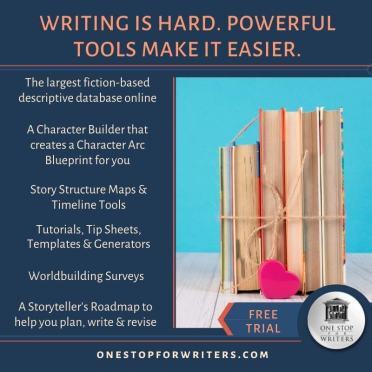
Let���s face it: it���s hard to make a living from book sales. But Ange and I learned early on that our skills as writers lent themselves to other ways of bringing in money. So we branched out as speakers, running workshops for local writing groups and at larger conferences. Then we explored another collaboration that resulted in One Stop for Writers, a subscription-based website that contains all our thesauruses (not just our books) and writing tools and resources designed by us that help writers in a new way.
Workshops and One Stop for Writers have provided additional revenue for us in and of themselves, but they also generated more sales by introducing us to new people who had never heard of our books.
Takeaway: What additional career opportunities could you pursue that utilize your writing skills? What else could you be doing ���on the side��� while you���re writing books? Here are some options you may not have considered.
Partner with the Right People
If there���s any one secret to Angela���s and my success, it���s that we found each other. It���s really, really hard to do this job alone. I can���t imagine having to handle everything by myself. At some point, most writers will need to partner with other people, be that a business partner, editor, agent, cover designer, copy editor, bookkeeper, etc. Those partnerships can save you���as long as you choose wisely.
Takeaway: Research potential partnerships carefully. Look for people who complement you, people who are strong where you���re weak. Find people who share your values and work ethic and are pulling in the same direction.
There’s more we could share, but this post is long enough already, and we’d rather hear what has worked for you. Let us know in the comments!
More quick facts about the books
Enter our celebratory giveaway
The post Selling a Million Books: What Worked for Us (and Can Work for You, Too) appeared first on WRITERS HELPING WRITERS��.
April 24, 2023
We’ve Reached the One Million Books Milestone!
Two novice writers met in an online critique group called the Critique Circle and became fast friends. Angela (a Canadian) wrote about zombies and pirates and a magical bookstore that kidnapped customers. Becca (an American) wrote everything from a coming of age YA during California’s Gold Rush to a dark tale of a doughy gingerbread boy being baked alive (and here you thought Angela was the weird one).
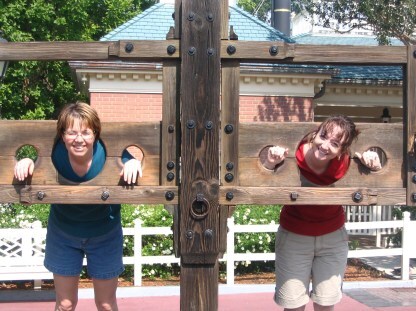 First in-person meet-up, Disney World, 2007
First in-person meet-up, Disney World, 2007The two also shared something else: a passion for learning and helping others. So they turned to studying the craft of writing and how they could help others work through common writing struggles.
One of the bigger hurdles writers faced was showing and not telling character emotion, so the two collaborated on a list of ways to show fear. This brainstorming list was well-received, and led to the next, and the next. Then in January 2008, they decided to start a blog so they could share these lists more widely. At The Bookshelf Muse, this collection of lists was given an official name: the “Emotion Thesaurus.”
This thesaurus became the first of many on different aspects of description, and finally, on May 9, 2012, they self-published their first writing guide: The Emotion Thesaurus: A Writer’s Guide to Character Expression.
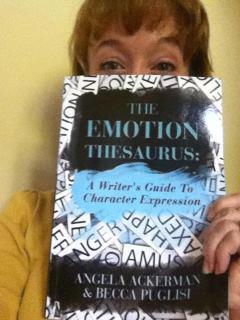 The first book!
The first book! Truth be told, it was terrifying. The industry wasn’t so keen on self-publishing back then, and some experts were vocal about how they believed writers were throwing their careers away if they self-published. To know about this bias and then put a book on the same industry-dominated shelf anyway took a lot of inner convincing, especially as this was their first publication, meaning they had no bestselling-this or editor-that to give them credibility.
But they did have something special. You.
Right from that first list, first blog, and first book, YOU were in their corner. You supported, cheered, and encouraged. You helped spread the word, told other writers about the helpful nature of this book, and then did the same for all the ones that followed.
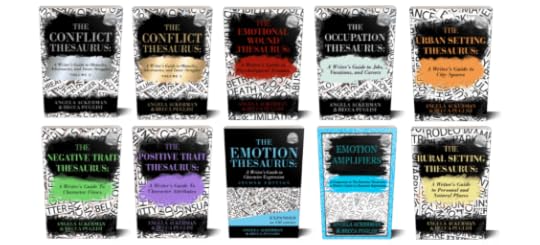 Thank you for being in our corner!
Thank you for being in our corner!Becca and I are stunned that a million of our books are in the world. Never could we have dreamt of being able to help so many writers, but we’ve been able to because of all of you. Your kindness, generosity, and support is unmatched. We are so grateful–thank you so, so much!
(Find Out More: Press Release & Quick Facts)
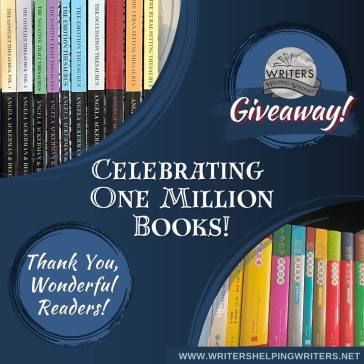 Giveaway Alert
Giveaway AlertA milestone like this calls for a special giveaway, so we reached out to our Resident Writing Coaches for help.
And boy, did they ever deliver!
Look at this incredible load of writerly things you can win…
The Prizes
A Story Audit from RWC & Editor, Lisa Poisso
This small but powerful diagnostic examines your one-page synopsis, a comprehensive assessment of the story’s narrative elements (story structure, plot, character arcs, conflict, and more), and an overview of the writing in your full manuscript. It will help you determine if your book is ready for editing, saving you time, energy, and money by diagnosing any big-picture issues before you pay someone for editing. A winner can redeem this Story Audit anytime after July 2023. (Psst. Lisa is great to work with!)

First 5000 Critique from RWC & Editor Michelle Barker
Your query letter and synopsis are important parts of the submission package, but your writing sample is the true test. In fact, many agents read the sample first. This service includes a developmental edit of your first 5000 words & complimentary access to Query Quest. Find out more.

Online Confidential Platform & Networking On Demand Course from RWC, Script Editor & Author, Lucy V. Hay
Marketing and platform building can be a challenge, but this step-by-step guide will help you utilize the online space to your best advantage as a writer or screenwriter. If you feel you aren’t getting traction online now, or you just don’t know where to start, this course will help you! Find out more.
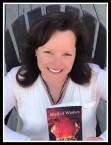
A Wicked Good Bootcamp Seat from RWC, Editor, & Author Suzy Vadori
The 8-week virtual book coaching experience will teach you to write a book that readers will love. Get clear on the story you���re dying to tell (and WHY you want to tell it), so you can turn it into a book readers actually want to read without compromising your creative vision. Skip the writers��� learning curve and get over a decade���s worth of Suzy’s insider writing industry tips in just 8 weeks to make your writing as strong as possible. Come away with a detailed action plan to get your ideal book written and into the world this year.

A Crime Scene or Climax Critique, (Winner’s Choice) from RWC & Thriller Author Sue Coletta
Attention, thriller & crime writers! This unique prize has been designed just for you from an expert in crime scenes, serial killers, tension, and suspense! (Did I mention she has her own Murder Blog?) Sue will assess your scene and offer feedback to help you ramp up the intensity. Note: the winner will need to provide a short synopsis of the story so Sue has context for the scene.

A $150 credit toward a Cruising Writers Writing Retreat with RWC & Author Christina Delay
Have you ever dreamed of joining a bunch of writers on a writing retreat in some beautiful location? Then imagine a situation where you get to visit several stunning locations, be pampered as you relax, and have a chance to learn and network with industry pros! Cruising Writers is a fantastic option for retreaters – rest, relax, and fill your creative well aboard a stunning cruise ship. The winner will get a hefty $150 discount on your package when you book! (Stating the obvious, but you must be a writer to win.)

A 20-Page Critique of Your Middle Grade or YA Novel by RWC & Editor, Marissa Graff
Wouldn’t it be great to have help with the opening of your story, especially from someone who was a freelance editor and reader for former literary agent Sarah Davies (ranked #2 in middle-grade fiction sales) for over seven years? Someone who has had clients go on to nab agents, sell their books, and even win the Newbery Award? Heck yes it would! Marissa Graff will help you bring out the best elements of your MG or YA opening by critiquing your first 20 pages.
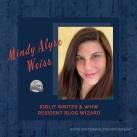
A Full Picture Book Critique from Our WHW Blog Wizard & “PB Fairy Godmother” Mindy Alyse Weiss
Mindy is the mastermind behind PBParty, an annual contest that connects talented picture book writers and author/illustrators with agents and editors. This has led to many success stories. Mindy has a ton of experience in what agents and editors are looking for in a picture book. The winner of this prize can send up to three PB manuscripts. Mindy will give light comments on two and in-depth feedback on the PB with the most potential.

A 1-Year Subscription to One Stop for Writers from your biggest fans… Becca and me!
We have created many thesauruses over the years, but not all of them become books…some go straight to a THESAURUS Database at One Stop for Writers. This web app is how we help writers beyond our books using powerful tools we’ve built to make it much easier to plan, write, and revise your way to a publish-ready book. Take the tour, start a free trial, and make sure to enter for a chance to win a 1-year membership! We’d love to help you bring your best story to the page.
To Enter:Want a chance to win one of these amazing prizes? Click the link below.
WHW’s 1 Million Book Milestone Giveaway
(Final day to enter is May 9th, 2023, EST).
Note, one entry per person. Prizes have no cash value and cannot be transferred. For full legal rules and conditions, please go here.)

Thank you again for all your kind support. We are honored to be part of your storytelling journey!
If you’d like to help us celebrate this milestone, feel free to share this post. And good luck in the draw!
The post We’ve Reached the One Million Books Milestone! appeared first on WRITERS HELPING WRITERS��.
Writers Helping Writers
- Angela Ackerman's profile
- 1017 followers



